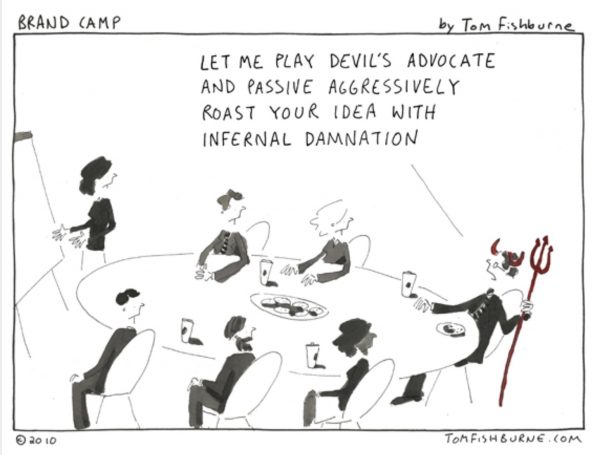Big brands need to ‘think young’ to fight the insurgents
Post by Prasad Narasimhan, Managing Partner based in Bangalore, India and Head of Brand Experience.
Big brands are trying to fight back against a rapidly growing tribe of insurgent brands attacking them, as we looked at in our research paper here.
Looked at differently, this is a battle between ‘old thinking’ invested in protecting the status-quo, and ‘young thinking’ which seeks to actively break the status-quo. Old thinking leads to what we call ‘marketing inertia’, where a big brand fails to evolve fast enough, leading to decline and eventually to its demise, as we posted on here.
In this post, I look at the barriers to young thinking and how to overcome them. The post draws on experience from the medical & pharma industry, but the ideas are applicable to any industry.
1. WHAT INHIBITS ‘YOUNG’ THINKING?
The ‘cage of conformity’
Most managers believe their companies value conformity, and hence avoid doing things differently. For example, it amazes me to see so many sales reps for pharmaceutical (pharma) brands trying to hard-sell their (often generic) molecule to cynical & even hostile doctors who want to keep such reps at bay. This ‘eyes wide shut’ approach continues, even when the diminishing results are painfully apparent.
The curse of knowledge
We tend to stick with familiar thoughts & ideas, relying on the “way it has always been done”, even when we see competitors slowly edging us out. For example, many pharma marketers still believe that their brand is nothing but the molecule they first launched it with, resulting in a chronic inability to see the brand through the eyes of the patient and her changing priorities.
The Devil’s advocate
This is a deadly creativity killer, especially when a brand needs to try something new. Managers, especially seniors, often assume they’re adding value by critiquing/challenging ideas as they emerge. However, new ideas need safe environments to develop and early scepticism.
Pharma, with its zillion of regulatory hoops, is a prime breeding ground for devil’s advocates, forever playing ‘whack-a-mole’ with new ideas. In a recent meeting where I was challenging a pharma team to go OTC, we faced several objections from old-timers, which all crumbled when challenged with new facts.

2. WHAT AIDS ‘YOUNG’ THINKING?
Be unreasonable
“The reasonable man adapts himself to the world; the unreasonable one tries to adapt the world to himself. Therefore, all progress depends on the unreasonable man,” said George Bernard Shaw. The Embrace Incubator is an example of unreasonable thinking from designers determined to create a cost effective solution to infantile deaths due to hypothermia. It costs only $25, compared to c.$20,000 for traditional incubators .

Demonstrate conviction
Personal conviction is critical for brand change agents, especially if this conviction comes from consumer intimacy. One pharma company I know has a passionate team using a deep understanding of the patient journey to create solutions for diabetics that enhance engagement, compliance & results. These solutions go ‘beyond the pill’ to blend education, apps, motivation and group dynamics to make real change happen.
Celebrate mavericks
Breaking free from conformity takes courage and requires mavericks. These rabble-rousers keep things from getting too comfortable and need space to work, plus a culture that values and encourages them. While its best to cultivate mavericks internally, such resources can also be brought in to boost creative thinking. One company that we are currently engaged with has specifically contracted us to challenge current ways and provoke brand teams to explore entirely new paths to growth.
Delegate
Brand leaders need to let teams know what is expected, then step out of the way and leave them to figure out how to do it. One pharma client focused on rare diseases found unique solutions precisely because it encouraged employees to use their ingenuity to find non-traditional solutions in what is otherwise a very unprofitable sector. Novel partnerships, unique funding ideas and fresh ecosystems are some of the ways in which they made a difference.

3. PROCESS TIPS to TURBO-CHARGE YOUNG THINKING
Constructive Dares
These are a great way to release the dopamine of innovation in teams. Big, specific, motivating challenges that are seemingly impossible (with sometimes even crazy constraints) can prime our brains to stretch. For example, mobile ECG machines created by GE teams in India at a small fraction of global costs are revolutionising patient access & care in rural India.
Ideal futures
Encourage teams actively to consider how things could be, not just how they are, to see an old problem with new eyes. For example, a brand targeting dysmenorrhea has been imagining new ways to alleviate period pain driven by a simple idea – periods are natural, but pain is optional. Solutions go beyond pills to explore devices, accessories and online communities.
Speed date the boss
This term originated in HP Norway where the MD set up regular one-on-one sessions with all employees challenging them to come up with suggestions. While pharma companies are traditionally hierarchical, a new breed of leaders is emerging, and we are seeing many such informal mechanisms that create ‘good pressure’ on employees to think wide and big.
SUMMARY
In conclusion, your thinking age doesn’t have to reflect your company’s physical age. Instead, it is about divine impatience and a constant appetite to change the game for the better and drive growth.


